|
About Chiropractic & Understanding Subluxation
|
| About Chiropractic |
"Get knowledge of the spine,
for this is the requisite for many diseases."
- Hippocrates
As a profession, the primary belief is in natural and conservative methods of health care. Doctors of Chiropractic have a deep respect for the human body's ability to heal itself and manage pain without the use of surgery or medication. Chiropractic is not an alternative to medicine, nor is it complementary to medicine. It is a separate and distinct science, art, and philosophy of health and healing, and it has become the most prevalent natural healing art in the world. A Doctor of Chiropractic is one who is involved in the treatment and prevention of disease, as well as the promotion of public health, and a wellness approach to patient healthcare.
Since Chiropractic is based on the premise that the body is a self-healing organism, and that the nervous system is the master control system of the body, Chiropractic care is all about the health of your spine. Minor displacements of the spinal bones, known as vertebral subluxations, can cause stress to the spinal cord, which acts as the main line of intelligence for the entire body. These displacements, or subluxations, are the cause of many unwanted health conditions. Although there have been many valuable techniques that have been developed in the Chiropractic profession, the Gonstead Method is considered a "gold standard" for Chiropractic because of its safety record and effectiveness in permanently correcting vertebral subluxation.
The roots of chiropractic care can be traced back to the beginning of recorded time. Writings from China and Greece written in 2700 B.C. and 1500 B.C. mention spinal manipulation and the maneuvering of the lower extremities to ease lower back pain. Hippocrates, the Greek physician who lived from 460 to 357 B.C. also published texts detailing the importance of Chiropractic care. |
|
| Understanding Subluxation |
"Find the subluxation, accept it where you find it, correct it and leave it alone."
- C.S. Gonstead.
A Vertebral Subluxation is best described as a breakdown in the communication between your brain and your body. Subluxation can occur when any form of stress, be it physical, chemical, or emotional, causes one or more of the spinal vertebra to become misaligned enough to cause spinal nerve pressure.
Your brain communicates with your body by sending and receiving messages along the spinal column. These messages are carried through your spinal cord and delivered to your body through the spinal nerves. When this communication is interrupted, it is referred to as vertebral subluxation. This can affect your overall health.
While some people have incurred subluxations in a traumatic injury, most subluxations initially occur without pain. When the damage is left uncorrected, symptoms are noticed only after tissue damage has already resulted. Subluxations affect every nerve in your body.
|
The following x-rays show a normal view of the neck, and the four stages of degeneration that can occur over time, if left untreated.
|
|
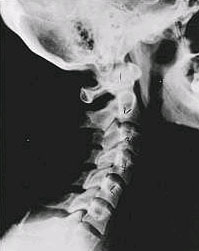
|
Normal
This is a picture of a normal spine. Compare this X-ray with the ones you will see below on this page. Notice the normal forward curve of the neck. This curvature helps absorb shock. Notice how each of the disc spaces between C2 (second bone in neck) and C7 are thick and even. Note that the front portions of each of the vertebrae are fairly open with clear and well defined borders (normal vertebrae in other parts of the spine have similar characteristics). If you have a subluxation in your spine that is left untreated, changes in the spine occur that result in damage to both the structure and function of the spine, and permanent nerve damage can result. |
| Phase One Subluxation Degeneration
This X-ray shows Phase One Subluxation Degeneration. Compare this to the X-ray above, and you can see how the normal curve in the spine is lost. In this example, the neck is actually curving in reverse, and the disc spaces have begun to slightly change in shape. Since this is only Phase One Subluxation, you can see that the body of each of the vertebrae (the square part in front) still exhibits clean clear borders. In this patient's case, segmental motion may be abnormal, but overall motion is probably not affected. It is interesting to note that most people with Phase One Subluxation Degeneration have no pain. |
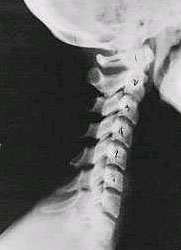
|
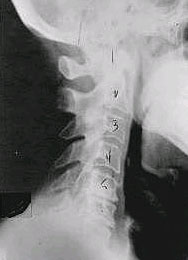 |
Phase Two Subluxation Degeneration
In this phase, some of the same characteristics of Phase One Subluxation Degeneration can be seen, as well as the loss of normal curvature and position, and a shift in segmental motion. People with Phase Two Subluxation Degeneration begin to display a reduction in their range of motion. X-rays of a Phase Two patient show calcium changes or buildup at certain levels of the spine, which are commonly referred to as spurs or arthritis. Also, the disc spaces between the affected vertebrae are narrower, and appear to be flattening out. |
| Phase Three Subluxation Degeneration
Phase Three has all the attributes of the previous phases, but they are more distinct. The curvature is abnormal, and the disc spaces are dramatically decreased and changed. The calcium projections on the spine are abundant. People in Phase Three suffer from a restricted range of motion and, upon presentation, are clearly exhibiting symptoms. |
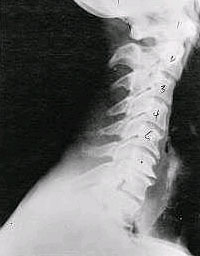 |
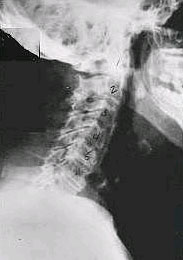 |
Phase Four Subluxation Degeneration
Phase Four is a grave condition that affects the patient's longevity and quality of life. Note that the X-rays of this Phase Four patient show not only massive calcium projections, but severe structural damage as well. The bones themselves even seem fused. People with Phase Four Subluxation Degeneration not only experience a severe restriction in their range of motion, but probably suffer from a number of other health issued due to the neurological damage caused by years of untreated subluxation. |
|



